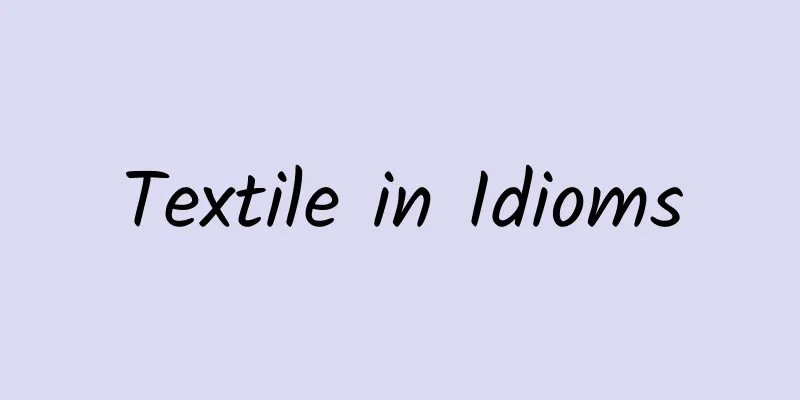Textile in Idioms

|
The Xujiayao Ancient Human Site in Datong, Shanxi Province was first discovered in 1974. Since 1976, three large-scale excavations have been carried out. More than 20 human fossils, more than 10,000 stone products, and a large number of bone and horn tools and mammal fossils have been unearthed in the site. Among them, the large number of stone balls is the most distinctive. According to research, the stone balls were thrown in a net bag (sling) made of ropes. It can be inferred that people had learned to use ropes at that time. Based on the experience of twisting ropes, people created the techniques of spinning and spinning. Spinning is to split the bark of plant stems into very thin long strands, and then connect them and twist them into threads. Because this is a highly skilled craft, people later called the achievement of work "achievements". Weaving technology evolved from the practice of weaving fish nets and baskets. The ancients gradually learned to use tools in practice, trying to tie one yarn after another on the same wooden stick, and the other end on another wooden stick in turn. After tightening and fixing the two wooden sticks, they could weave like weaving mats. The tightened longitudinal yarn is called warp, and the yarn woven in horizontally is called weft. The "heald" is the mechanism on the loom that lifts and lowers the warp to receive the weft. One heald can lift thousands of warp threads, so it contains the meaning of "total gathering" and "collection". Thousands of different warp threads are combined through "healds" for easy operation, so there is the word "comprehensive". The "heald" controls the movement of the warp yarn. Once a mistake is made, not only will defective cloth be produced or the cloth cannot be woven, but troubleshooting is also very troublesome, "complex"! China is known as the country of silk. Our ancestors selected and bred silkworms from mulberry pests, created silk reeling and silk weaving techniques, and wove high-quality silk fabrics that are both good for clothing and combined with art. The famous Silk Road reflects the contribution of the Chinese nation to world civilization. "Brocade" refers to silk fabrics with colorful patterns, and "embroidery" is to sew colorful threads on silk or cloth with needles to form patterns, designs or words. "Jinxiu" has become an adjective for beautiful or wonderful, such as brocade on the top and splendid China. Textiles have a history of thousands of years in my country, promoting social progress and development, and are closely related to the development of culture. In the Chinese language, there are more than 560 Chinese characters with radicals such as 巾, 亻, 纟, etc., which are directly or indirectly related to textiles. Many words and idioms we often use are also borrowed from textile terms, such as: 盤盤自束, 經學經經學, 流流膠不绝, 细丝入扣, 经天威地, etc., which contain a strong Chinese textile culture. |
>>: Is liposuction really safe? You will understand after reading this!
Recommend
Friends who buy cars in 2018, please pay attention to these new car policies @ you
The policy of halving the purchase tax for cars w...
A review of extreme weather in 2023! How will the weather evolve in 2024?
As 2023 is coming to an end, I will first review ...
How to improve activity and retention? A brief analysis of the user growth system in financial apps!
The user growth system refers to modules or funct...
The founder of Meitu XiuXiu tells his own story: How did Meitu XiuXiu become popular? Make down-to-earth and spirited products!
Wu Xinhong, founder of Meitu , shared his experie...
Content Operation丨How to maximize the value of Internet celebrities?
As an investor, I am unlikely to choose to invest...
How much do you know about product conversion: 4 analysis models for high conversion
What is conversion Conversion includes two things...
iPhone 4S is in trouble after upgrading to iOS 8
Apple finally released the official version of iO...
Is a WeChat mini program required to have a public account? Is it necessary to have a public account to create a mini program?
Is a WeChat mini program required to have a publi...
Piling up mountains to create landscapes and recycling to build houses, urban construction waste is not "garbage"!
We currently have more than 900 million people li...
Chinese, Japanese and Korean companies compete to become iPhone screen suppliers. Who will be the new winner in the OLED era?
The stimulating effect of Apple iPhone X on the m...
NetEase Cloud Music Product Analysis
1. Introduction After analyzing the iterations of...
Toutiao video information flow advertising marketing plan!
Toutiao video information flow advertising market...
The secret of high ROI advertising—data analysis and optimization
To become an excellent marketing operator/growth ...
Why do we need to build an Apple bidding intelligent delivery platform?
It was somewhat difficult to adapt to the transit...
Android 5.0 is a tragedy: automatic encryption makes the system super slow
On November 24, in response to the endless reques...









